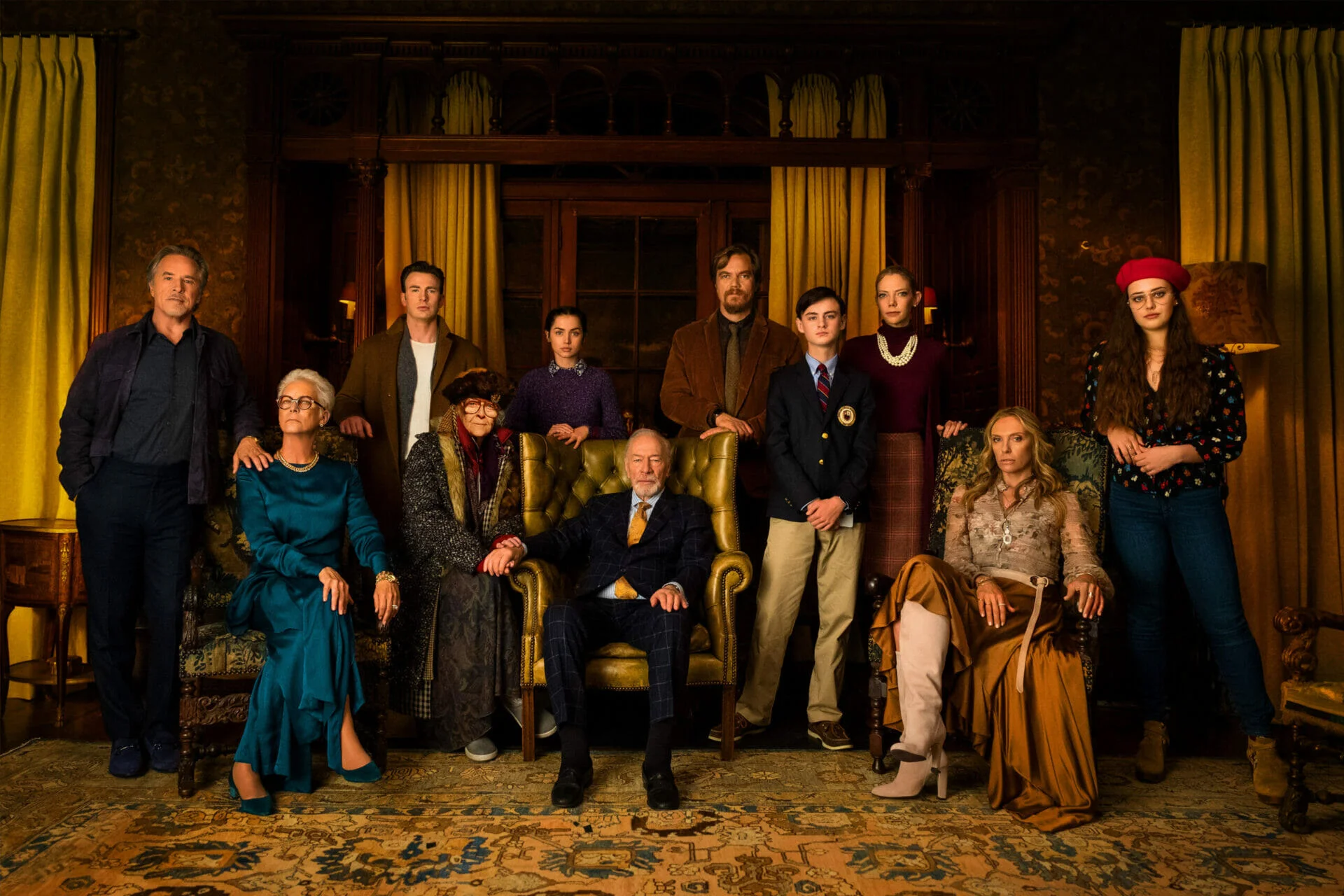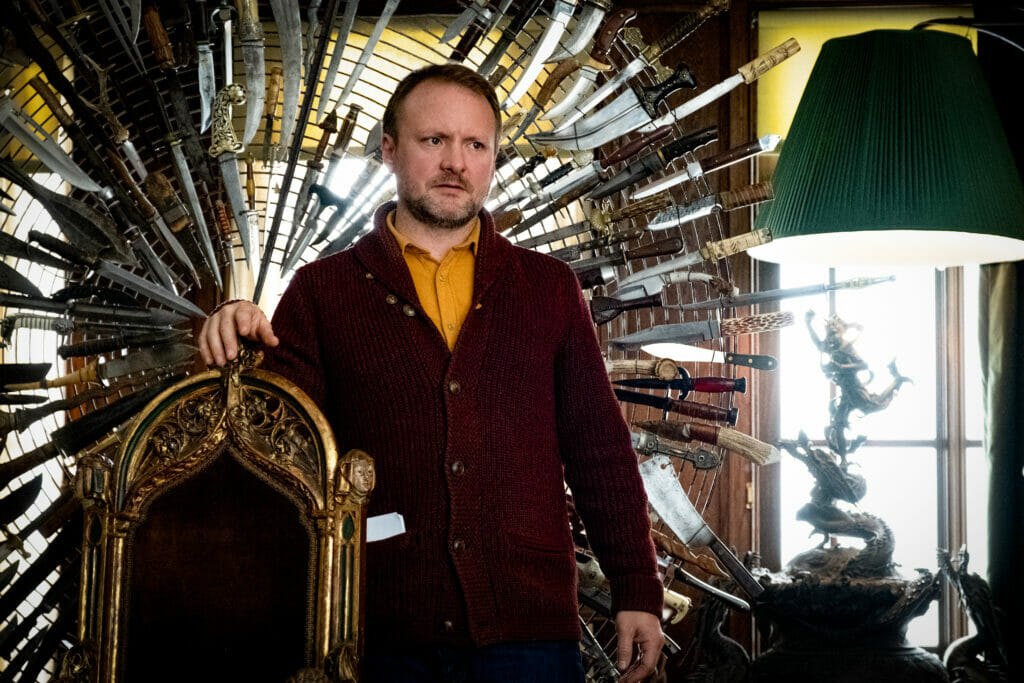
Knives Out | Detective Fiction in Trump's America
Year
Runtime
Director
Main Cast
Writer
Cinematographer
Production Designer
Music by
Country
Format
A popular novelist has been found dead with his throat slit. In the charming setting of a vast Massachusetts mansion, a kooky detective investigates the shady affairs of a disparate and quarrelsome family in search of an explanation for the old patriarch’s death. This might seem like the script for an old-fashioned detective story, where tiny but crucial clues lead to the butler being charged with the murder of his secretly loathed employer. In Knives Out, however, there is no butler. Instead, viewers will find a young South American nurse who happens to be the true protagonist of an unconventional mystery flick.
Rian Johnson, best known for his contentious contribution to the Star Wars franchise, has never hidden his passion for twisting the canons of genre. Knives Out, now part of the Netflix catalogue along with its 2022 sequel Glass Onion, is no exception. Daniel Craig and Ana de Armas – also thrown together in the latest James Bond installment, No Time to Die (2021), as Agent 007 and the Bond Girl – are the two outliers in a cast that plays the Thrombeys. “This is a very rich family that, as some rich families do, often looks both indulgent and stupefyingly tacky,” writes Linda Holmes. Much like the popular TV show Sherlock, the movie reinterprets the stylistic features of classic whodunnit from a contemporary point of view, with a fierce and cathartic social critique of the underside of the upper classes.
At the same time, the director throws down a gauntlet to the public, creating a deliberately labyrinthine structure that flirts with the rules of the genre. Everything shown on screen, but especially everything the characters say in their seemingly trivial dialogues, has a specific place in the final resolution. It is up to the viewer to decipher the web of clues, the twists and turns scattered throughout the plot, and win Mr. Johnson’s game.
Who murdered Harlan Thrombey?
Like any good detective story, Knives Out begins with a corpse. Harlan Thrombey (Christopher Plummer), a renowned crime novelist, is found dead after celebrating his 85th birthday with his family. Preliminary police investigations support the suicide hypothesis. But this does not convince Benoit Blanc (Daniel Craig), a famous private detective mysteriously hired to solve the case. Indeed, he suspects that a murderer may be hiding among Thrombey’s relatives, ready to lay their hands on the victim’s conspicuous wealth. With Harland’s nurse Marta Cabrera (Ana de Armas) as his unlikely Dr. Watson, Blanc begins to dig into the family’s murky relationships to uncover an uncomfortable truth.

It takes no effort to trace the influence of the most celebrated novels by the 19th and 20th-century masters of whodunnit. As in Agatha Christie‘s The Murder of Roger Ackroyd (1926), the entire plot revolves around the demise of a patriarch and the division of his inheritance among seemingly upstanding descendants. The locked-room mechanism, in which the crime seems physically impossible to commit, has eminent antecedents in Edgar Allan Poe, Sir Arthur Conan Doyle, and Ellery Queen. Not to mention that the Thrombey mansion is visually the quintessential crime scene (a bit like the Arconia from Only Murders in the Building). Production designer David Crank combined three different locations around Boston to achieve the desired result: an old-fashioned, labyrinthine dwelling filled with quirky objects and props. The house of mystery everyone has in mind.
The American Film Institute, the National Board of Review, and Time magazine all included Knives Out in their respective lists of the top ten movies of 2019.
Playing with a genre
At first glance, Knives Out has all the hallmarks of a prototypical detective story. However, the movie is not a mere homage to the golden age of mystery novelists. Unlike other recent narratives, such as Kenneth Branagh‘s version of Murder on the Orient Express (2017), Knives Out uses the tropes of the genre only to break away from them and subvert their canonical structure from within. This becomes clear when comparing the movie to Knox’s Decalogue, a list of ten commandments written with the approval of the Detection Club, including none other than Agatha Christie. One can observe how the director included almost all the rules in the script, only to circumvent them in a cunning and subtle way.
“What I like about genre is it gives you a game board between you and the audience, where you both know the rules of the game. They know when you are playing by those rules and when you are breaking them. This creates a very interesting meta-conversation between you and the audience. “
From Rian Johnson’s conversation with Denise Villeneuve for The Director’s Cut (2019)
The fact that the victim is himself a mystery novelist creates, albeit implicitly, a meta-narrative dimension and winks at the public. The plot is actually a pretext for a challenge between the director and the viewer. Detective fiction is in itself an interactive genre, as it implies the active participation of the viewer. Johnson has managed to take this feature to the highest level by shaping the movie as an animated Clue board game – something ironically hinted at by one of the characters. It is still a fair game, with an ending that comes full circle, leaving the viewer entertained but not fooled.
Benoit Blanc: a traditional, disruptive detective
Benoit Blanc is in many ways the typical detective. His main inspiration, as his French-sounding name suggests, is indeed Hercule Poirot. Like the Belgian protagonist of Christie’s novels, and similar to other popular figures such as Sherlock Holmes, Blanc is an out-of-the-ordinary character, distinguished by his fancy looks, unruly manners, and polite humor. Defined by a fictional New Yorker headline as “the last of the gentlemen sleuths,” he dresses in tweed suits and smokes elegant cigars, becoming an anachronistic presence in a contemporary context. To emphasize his fish-out-of-water position, Craig added a heavy Southern accent to the character’s performance, in stark contrast to the New England setting.
At the same time, Johnson created the character in such a way as to remove him from the canons of the genre. For almost the entire first act, Benoit Blanc remains at the edge of the scene, immersed in the half-light and engaged in a tacit observation of events. Much like Lieutenant Columbo, he seems to play a passive role, beguiled by the other characters’ schemes and unable to solve the mystery. Moreover, in contrast to most crime fiction, the point of view of the viewer in Knives Out does not coincide with that of the detective. Marta Cabrera, indeed, is the true heart of the movie, torn between the roles of Blanc’s confidante and lone participant in an intricate and treacherous game. But it is Benoit Blanc himself who comes out on top in the grand finale, demonstrating the virtues of a discreet, unobtrusive but effective method of investigation.

The Thrombey’s subtle racism
Although its setting suggests a movie suspended in time, Knives Out is a profoundly contemporary piece of work. Once again, the big name behind Johnson’s inspiration is Agatha Christie: like her novels, which offer an insight into the vices and virtues of 20th-century England, the movie provokes reflection on major social issues of the current times. The first of these is classism, less central than in works such as High and Low and Snowpiercer, but still relevant to the overall meaning of the movie.
Behind their high-sounding last name and lavish mansion, the Thrombeys are a dysfunctional family held together by toxic relationships and, deep down, united only by an interest in the deceased’s inheritance. From Walt (Michael Shannon), who manages his father’s publishing company as if it were his own, to Jony (Toni Colette), alleged lifestyle guru and owner of a failing skincare brand, everyone claims to be a self-made entrepreneur. In truth, they are all living off of Harland’s wealth, refusing to acknowledge their favored status.

On the other side is Marta. She is a kind-hearted nurse from an illegal immigrant family, who is not interested in the money race and, unlike his offspring, really likes Harland. Yet none of them can really remember what country she comes from or had any intention of inviting her to the funeral. The Thrombeys make an irreverent and dramatically realistic satire of a widespread contemporary attitude that hides behind false politeness the most narrow-minded version of conservatism. Statements such as “America is for Americans” clearly echo Donald Trump‘s slogans and expose the hypocrisy of a family whose only concern is defending their unearned privileges.
Cameos and viral sweaters
The plot is not the only element of the movie that has been meticulously crafted. Knives Out is filled with Easter eggs that pay homage to the most beloved symbols of detective fiction, as well as other mainstream icons. Spotting them all is another challenge the director throws at the viewer. Fans of the genre will melt when they see Angela Lansbury as an unusually Spanish-speaking Jessica Fletcher on a small TV screen. Only true cinephiles will get the references to Joseph Mankiewicz‘s 1972 movie Sleuth. Instead, any Game of Thrones aficionado is sure to catch a glimpse of the chair surrounded by a knife spiral where Blanc interrogates the Thrombeys, a neat reference to the ominous Iron Throne.

Add to this the strange case of the coarse knit sweater worn by Chris Evans, who plays Harlan’s shady grandson, Ransom, for much of the movie. The garment inexplicably went viral, so much so that several clothing brands sold out of their knitwear by Christmas 2019. It is unlikely that Rian Johnson foresaw this. Still, it is one of the mysteries that Knives Out continues to captivate moviegoers with.
Tag
Buy a ☕ for Hypercritic








